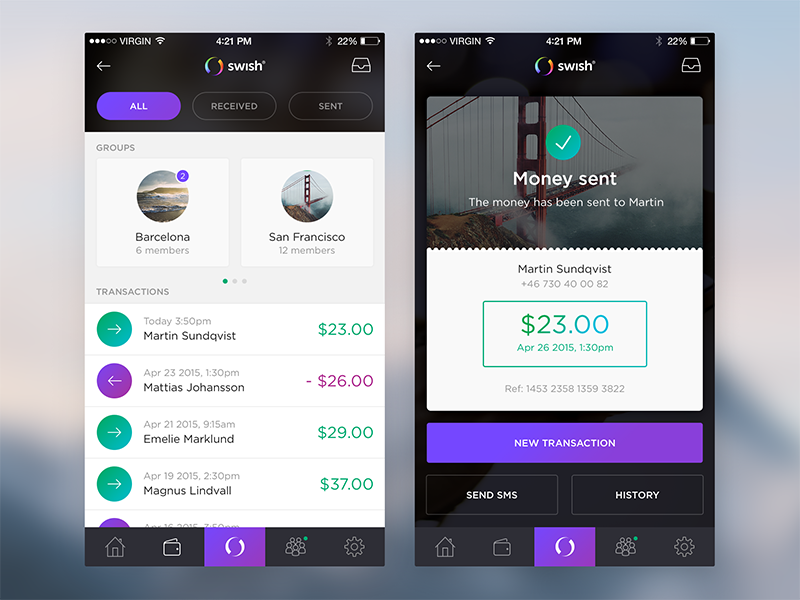Many people like to talk about crypto adoption in broad and sweeping terms. However, the big debate surrounds where cryptocurrency might be adopted first at scale. Though it is impossible to predict the future, cryptocurrency projects and enthusiasts alike tend to discuss adoption in terms of developed and developing markets. In this article, we’ll explore the core arguments for each and highlight some of the initiatives being pursued by projects to hasten mass adoption.
The Argument For Developed Markets

Image source: https://www.thelocal.se/20161215/things-to-do-if-youre-stuck-in-sweden-this-christmas
Although many developed markets are commonly characterized by a stable fiat currency and relatively low levels of inflation, some are already nearly cashless societies. In nations like Sweden, just two percent of the total value of all transactions made by Swedish citizens are made with cash. On the other side of the fence, 98% of consumer payments in India use cash. The interesting thing about developed nations like Sweden is that they are close to achieving a position where physical fiat currency is no longer an effective method to execute everyday transactions. Indeed, many stores in Sweden simply do not accept cash at all now.
The rise of a nearly cashless society in Sweden has been enabled by the meteoric rise of apps like Swish. These apps give users the ability to link bank accounts and to send or receive payments with a few taps on their smartphone. The Swish app now boasts over 6 million users which is a staggering 60% of Swedens population. What’s important here is to understand that Swedes are very accustomed to using digital cash and transferring value with apps. At its core, it’s not that big a jump from using an app like Swish and using cryptocurrency as a means of exchange.

Image source: https://dribbble.com/shots/2048812-Swish-App-Redesign
Within Swedish society, it is very possible to live in major cities and not use cash whatsoever. It is true that under Swedish law that merchants are obligated to accept cash by means of payment, however, many exploit loopholes in the legislation to gain an exemption. This has led to some stores putting up signs saying that cash is not accepted. In short, Swedes are a population that is very used to money being digital and regularly transact value using apps on their mobiles. For many cryptocurrency supporters, the next step in the evolution of money is cryptocurrency and developed nations like Sweden have a population that should, in theory, be able to transition between the monetary systems with little friction.
Sweden’s national bank has also gone as far as suggesting that it was considering the creation if it’s own national digital currency called the E-Krona. Even though Sweden’s national bank, Riksbank, is pushing for a state-backed cryptocurrency, most do not believe it will happen anytime soon. As Sweden’s use of cash diminishes, calls for a national cryptocurrency are only likely to increase. Regardless of whether Sweden goes full crypto anytime soon, the progressive thinking of the Swedes places this small nation at the forefront of a potential monetary revolution. Many point to Sweden’s progressive thinking, nearly cashless society and the population’s high levels of adoption for mobile payments to argue that Sweden is probably the most likely nation on the planet to first adopt cryptocurrency at scale.
Could Crypto Replace Fiat In Sweden Anytime Soon?
Image Source: https://e-axes.com/wp-content/uploads/2018/11/e-krona.png
Many would say that the centralized nature of the proposed E-Krona means that it is not a true cryptocurrency at all. Regardless, many commentators do not foresee the E-Krona being deployed for at least two years and suggest it could take the better part of a decade to roll out. If these claims are to be believed, then there is scope for Swedes to adopt an alternative cryptocurrency like Bitcoin or Ethereum before the E-Krona makes it’s highly anticipated appearance.
The key question is whether a cryptocurrency like Bitcoin can really replace the Krona overnight? The answer is probably not and it’s important to make a distinction between mass adoption and ‘total adoption’. If Sweden were to mass adopt cryptocurrency then the most likely outcome would be that crypto would be a relatively widely used alternative to the Krona, rather than replacing it overnight. This would mean that cryptocurrencies like Bitcoin and the Krona would have a period where they co-existed side by side.
Problems That Need To Be Overcome
Image source: http://anthillonline.com/wp-content/uploads/2018/09/eCommerce.jpg
When it comes to mass adoption, the current issue posed by the co-existence of fiat and cryptocurrencies is that the two systems are currently connected very poorly and there is significant friction when transferring value from the traditional banking and cryptocurrency ecosystems. Many people view the building blocks of cryptocurrency adoption as being widening merchant acceptance of crypto. Fundamentally, this does appear to make sense for if crypto is to transition from a speculative asset class to a medium of exchange it needs to be accepted widely to enable its exchange for goods and services. However, the issue is that the vast majority of merchants have operating costs and have to pay suppliers in fiat. This means that most businesses cannot simply accept crypto and hold it. Instead, they are forced to sell any crypto they receive in payments and convert it to fiat to continue operating their businesses.
This need for merchants to convert cryptocurrency received for fiat is currently being served by crypto payment processors like Bitpay. However, the issue here is that fees as high as 5% can be charged by crypto payment processor companies. The numbers simply do not match up when you consider the operating margins of most online businesses. These margins can be as low as 0.5% to 3% and this highlights the very real need for a low-cost merchant solution to enable the wider adoption of cryptocurrencies in the real economy.
It’s not surprising that merchants care about the bottom line. Research from the Bank of Canda supports the idea that merchants prefer to accept the payment method with the lowest fees. The bank looked at a typical transaction of $36.50 and determined the costs by payment method.
- Debit cards: 19 cents or 0.52% per transaction.
- Cash: 25 cents or 0.68% per transaction.
- Credit cards: 82 cents or 2.25% per transaction.
In a survey of 500 merchants, the Bank of Canda generated the following results on the preferred payment method for merchants:
- Preferred debit cards 53%
- Preferred cash 39%
- Preferred credit cards 5%
The key thing to take away from this research is that merchants tend to prefer the lowest cost payment method and that any crypto merchant payment solution should really have fees lower than 0.52% to be more attractive to merchants than debit cards. This issue is that well-known crypto payment processors such as BitPay charge 1% or more for converting crypto into fiat, which is significantly higher than the cost of using traditional payment methods. This means a cheaper solution is needed to usher in the mass adoption of crypto at a merchant level.
A Solution To The Merchant Adoption Problem?
When people talk about the merchant roundtrip, this is simply a way of saying that a customer wants to pay in crypto and the merchant wants to receive fiat. The key thing here is that this is likely to be the case for the foreseeable future, as long as fiat remains the accepted unit of account. Crypto payment processors provide a solution to the merchant roundtrip problem. However, as highlighted previously, the fees involved mean that crypto is unlikely to be adopted at scale or offer merchants advantages over traditional payment methods. Another potential issue with crypto payment processors is that they take custody of the crypto asset and both the merchant and customer need to trust the company behind the payment processor. Many of you who have been in cryptocurrency for a while will know the potential pitfalls of trusting entities with your crypto and this can also act as a headwind for merchant adoption of crypto via payment processors.
Nimiq OASIS
The good news is that there is an under the radar cryptocurrency project called Nimiq who are making progress on solving this merchant roundtrip problem. The first element of this solution is called Nimiq OASIS which is a blueprint for a potentially revolutionary crypto-to-fiat bridge in collaboration with WEG Bank. The solution aims to enable the frictionless exchange of value between the traditional banking and crypto ecosystems by focusing on making fiat currency blockchain compatible and enable ETH, BTC, and NIM to EUR exchange, which is triggered on a non-custodial exchange platform.
The partnership with WEG Bank is key to enabling access to the SEPA Network and potentially enabling crypto to fiat swaps at any of the 2,000 European banks which are part of the network. Essentially, Nimiq OASIS aims to provide a new easier way for people to buy or sell crypto for fiat with their bank account. The key thing with Nimiq OASIS is that the project’s team are not restricting the solution to just their cryptocurrency and have stated that they also intend to support Bitcoin and Ethereum upon launch. Nimiq OASIS has a target go-live date of Q4 2019 and this new technology could play a key role in disrupting how value is transferred between the crypto and traditional banking ecosystems.
Although Nimiq OASIS is currently just a blueprint, Team Nimiq have also back up this research with substance by acquiring a 9.9% stake in WEG Bank.
An Alternative Solution To The Merchant Roundtrip
Nimiq’s vision is to combine Nimiq OASIS with a multi-cryptocurrency checkout and a fiat atomic swap liquidity providing entity to solve the merchant roundtrip problem in a non-custodial fashion. This means that a customer can pay in cryptocurrency and a merchant can receive fiat without having to trust a crypto payment processor. In fact, the solution cuts out the need for crypto payment processors entirely.
This complete, scalable, multi-cryptocurrency and low-cost solution aims to solve the merchant pain points of accepting and could play a vital role in the near future to widen the merchant adoption of crypto in developed markets like Sweden.
The Argument For Crypto Adoption In Emerging Countries
Some in the cryptocurrency community believe that there is actually very little need to adopt crypto in developed countries. The reason is that people living in these types of countries enjoy relative stable national currencies which, on the whole, work just fine as a medium of exchange and a store of value. However, there are countries in the world with poor payment infrastructure, oppressive capital controls, high numbers of unbanked people and hyperinflation. It is argued that these types of attributes create an environment where cryptocurrency is actually needed to act as an alternative to government mismanagement of the economy or to bank those excluded from the traditional financial system. Many people like to make the simple argument that where cryptocurrency is actually needed, it will be adopted.
Dash In Colombia
Image source: https://dashnews.org/wp-content/uploads/2018/08/dash-colombia.jpg
Dash is one of the most popular cryptocurrencies and has certainly taken the lead when it comes to targetting and committing resources to the adoption of crypto in emerging markets. In 2018, the project ramped up efforts in Colombia and successfully onboard over 300 merchants and reportedly increased wallet numbers by 25%.
George Donnelly, the Dash coordinator in Colombia, has spoken about how many of these new Dash merchants had never heard of cryptocurrency before and how Dash is the only crypto they have heard of due to the team’s efforts in the region. He went on to say:
“The developing world is virgin territory for cryptocurrency. By committing to a developing-world strategy, Dash can dominate the regions where crypto is most apt to take hold first.”
Mr. Donnelly also commented on how many of Dash’s Colombian merchants were restaurants and that he believed this was due to the industry being more open to change. He did go on to say that merchant adoption was lagging in businesses with low-profit margins because they could not handle the volatility of crypto prices. The interesting thing here is that if Mr. Donnelly is to be believed that Nimiq’s merchant solution could add significant value to the merchant adoption of crypto in an emerging market setting as well.
Dash And Venezuelan Adoption
Image source: https://dashnews.org/wp-content/uploads/2017/08/Venezuela-dash-digital-cash.jpg
Venezuela could be the most likely country in the developing world to adopt cryptocurrency due to its poor payment infrastructure, capital controls, high numbers of unbanked people and the highest hyperinflation on the planet. Indeed, rampant inflation is so bad that cash is now almost unusable for regular transactions.
Despite the dangers, Dash has forged ahead with adoption efforts in the country and has successfully onboarded over 2,200 merchants. Indeed, Dash claims that their coin is the most widely used cryptocurrency for daily transaction in the country.
Although Dash has mainly been focused on promoting their own coin in developing markets like Venezuela and Colombia, they have also pioneered in the area of charity too. Dash Text was tested in a school in Venezuela with the aim of ensuring that children in the school had the ability to eat breakfast. Donators anywhere in the world could send $1 a day using this distributed charity system where donations were split equally amongst the target recipients. Dash selected the fifty most food insecure children to participate in the scheme and taught the employee in the cafeteria how to accept Dash payments.
It must be stressed that although Dash has made outstanding progress in terms of emerging market adoption of cryptocurrency, even their current efforts fall way short of what anyone can regard as mass adoption. However, it must be said that the Dash team have made a fantastic start in spreading adoption and have ventured into countries where few crypto projects are willing to go.
Conclusion
The debate surrounding where cryptocurrency is most likely to be adopted first is likely to rage until we actually see the first country adopt crypto at scale. There are compelling arguments for both developed and developing nations. However, what’s particularly interesting are the different strategies that projects like Nimiq and Dash are pursuing to encourage adoption. Which country or crypto adoption method will succeed? We’ll let you decide.
Disclaimer: The author holds some NIM in their portfolio and is compensated in a long-term independent consulting capacity by Nimiq. This article must not be construed as investment advice. Always do your own research.
